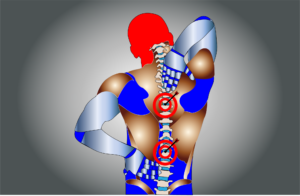Back pain
 Pain in the area of the lumbar spine, also known colloquially as low back pain, is referred to in medical terminology as lumbago, lumbalgia or lumbar spine syndrome, while the terms dorsalgia or BWS syndrome include pain in the area of the thoracic spine. Common terms for pain in the cervical spine or neck are cervical pain, cervical or cervical spine syndrome. Pain radiating to the extremities is also called ischialgia or lumboischialgia in the lumbar spine and brachialgia or cervical brachialgia in the cervical spine.
Pain in the area of the lumbar spine, also known colloquially as low back pain, is referred to in medical terminology as lumbago, lumbalgia or lumbar spine syndrome, while the terms dorsalgia or BWS syndrome include pain in the area of the thoracic spine. Common terms for pain in the cervical spine or neck are cervical pain, cervical or cervical spine syndrome. Pain radiating to the extremities is also called ischialgia or lumboischialgia in the lumbar spine and brachialgia or cervical brachialgia in the cervical spine.
Lumbago is the popular term for a sudden, stabbing pain in the back caused by irritation of the sensitive supply to the spine, i.e. the nerves that supply the spine itself – i.e. not by constriction of one or more spinal nerves that supply the rest of the body. It is a frequently acute, initially segmental (relating to a section of the spinal cord), usually stabbing back pain, which is often associated with a feeling of paralysis, forced posture, immobility, hard tension, spinous process pressure pain, etc. After a painless interval, it is possible that the pain may become chronic.
The differentiation from nerve root irritations such as sciatica syndrome requires a lot of experience and expertise. One speaks of a “pseudoradicular symptomatology” or facet syndrome if the area of pain radiation does not correspond to the dermatome (skin supply area) of a spinal nerve.
Causes of back pain can include vertebral fractures, herniated discs, spinal stenoses and slipped vertebrae, but also degenerative spinal diseases. Diseases such as Scheuermann’s or Bechterew’s disease as well as tumorous causes of the vertebrae can also lead to back pain.
In manual medical examinations, unspecific back pain is usually accompanied by articular dysfunctions (blockages), especially in the lumbar spine, sacroiliac joints and joints of the costal vertebrae. These can be the cause or consequence of the complaints.
In the case of pain in the area of the back, the presence of internal diseases (headache zones) must always be considered. Respiratory pain can be caused by pleurisy (inflammation of the pleura), load-dependent pain by coronary heart disease and food-dependent pain by duodenal ulcer. Biliary colic and often radiate into the right shoulder and occasionally into the back, as does the pain of pancreatitis,
An acutely occurring severe pain between the shoulder blades is the leading symptom of aortic dissection. Heart attacks and pulmonary embolisms can also manifest themselves in the form of sudden back pain. Pain in the area of the lumbar spine should also be considered in the form of inflammation of the renal pelvis and kidney or ureter stones. Shingles (unclear pain before the appearance of typical skin blisters, gynaecological diseases (complaints in the lumbar spine region) and acute Lyme disease (mostly wandering back pain) are possible triggers.
Further causes can be for example: tense muscles, bad posture, overweight, too little movement, sitting for long periods, as well as everyday, mental or professional stress.
Our approach to individual diagnostics and therapy is explained in detail under the point “pain therapy”.


